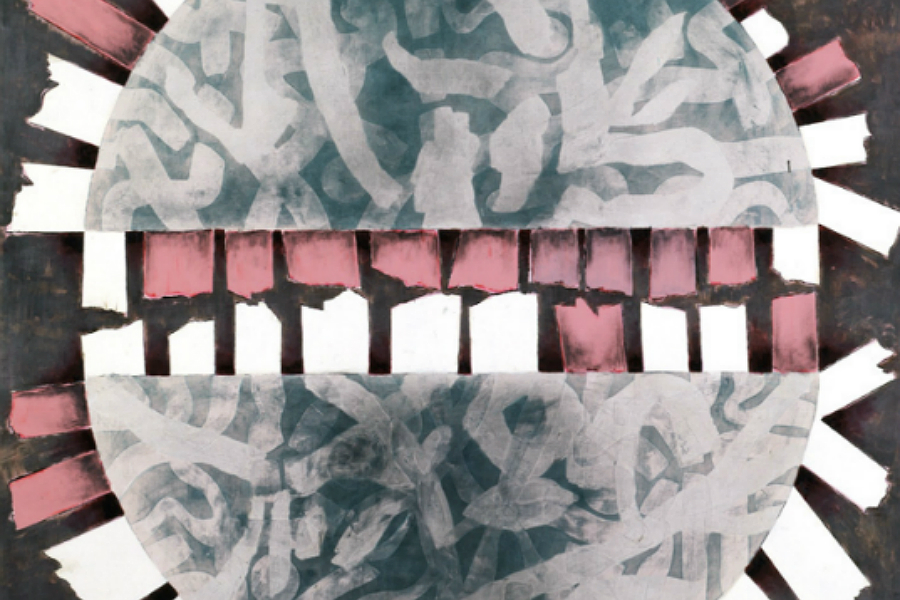Charline von Heyl: Now or Else

Come with us as we take a guided tour around Tate Liverpool’s latest exhibition, as seen through the eyes of the artist…
It seems to us Tate Liverpool’s current artist in residence is on the charm offensive. She’s only visited the city once before, briefly – to get the lie of the land in the gallery space – and Charline von Heyl already has a grasp on the lingo. “Liverpool to me seems so alive; it feels really something special that way…it really made an impression, there’s a really good, sound [!] vibe here.” Maybe she picked up one of those awful ‘Lern Yerself Scouse’ books on her travels, or perhaps she’s just astute.
Looking at her work, we’d gamble on the latter every single time. To glance at a Charline von Heyl is to do her work an injustice. That initial glance provides only part of the picture, making the paintings appear somewhat flat, employing what appears to be watered-down acrylic. But your eyes won’t have got the full picture first time around. The simplest way for the eyes to read a painting is foreground, medium, and background. It is also, of course, how we perceive the world around us; most of us, at least. For von Heyl, it’s more a matter of inverting that understanding in her practise. “The eye always wants to see a whole, things need to make sense. It’s counter-intuitive, often painted in reverse.”
Our time with Charline begins sitting down, but so pleased is she with how the show compliments the gallery space, and vice-versa, that she springs up and we end up on something of an artists’ tour, which suits us just fine. “You get a lot of cross-references through the space – the paintings line up like grids, it really worked – the space became architecture that way… [the paintings] are not chronological. The space is anti-linear as the paintings are.”
Given sufficient time and observation, it’s these anti-linear, counter-intuitive qualities that hold the attention and demand a second, lingering look, which becomes an extended study if you let it. With pieces such as King Midas in Reverse / (red but green), which to us seems elevated from the canvas, insight from the artist provides yet further depth. “I wanted to paint something red and green at the same time. Depending on how the light hits it, it’s pink or green. It’s a total paradox, a pull that exists in all of the paintings.”
It’s certainly true that her work has that ‘pull’, you feel it as you gravitate from one to the next. Another thematic touch is the deployment of layers in the paintings. Orpheus is a classic, beautiful example of von Heyl’s trade-mark style. In a way, this provides them with more of a relationship to collage than traditional realist paintings, but like some of the best paintings, there’s always something you’ll have missed the first, second, or even third time you look.
Much has been written about her techniques, but we wanted to hear it straight from the artist. What’s the method, and how does she know when it’s ready to be released into the world? “I want to charge the paintings with something for myself. I don’t think about the viewer – my life would be miserable without them, but the process is for me… It’s like… d’uh! Could I have imagined any of this work? The images aren’t in my head before I produce them, but they end up in the world. The moment comes when there’s nothing more to be done with the painting. It’s finished when it knows more than I could have ever known – looking at it and wondering about it – that’s kind of sexy!”
The idea that the paintings ‘know’ more than she ever could is an interesting one, especially when she adds, almost as an afterthought: “I walk around the gallery and think; I could never have done these! I was actually looking at my work thinking I wonder what the artist thought about this!?” Oh, to be in the head of Charline von Heyl, or even better, one of her paintings.
Come this point, we sense our de-facto tour guide may have had enough of the media-maelstrom for one afternoon – she’s flagging. But we want to know one more thing. She likens her practise to that of a writer: “The difficulty is like a writer with an empty page. You just start somehow, you might cross out the first sentence, but you have a start at least.” As she gets older, she says that first new sentence is harder to come by each time. With that in mind, how does she keep going? “Cos I’m a frigging painter!” And that’s reason enough for us.
Charline von Heyl: Now or Else, continues at Tate Liverpool until 27th May, admission, £8/£6
King Midas in Reverse / (red but green) 2009 © Charline von Heyl, Private Collection





